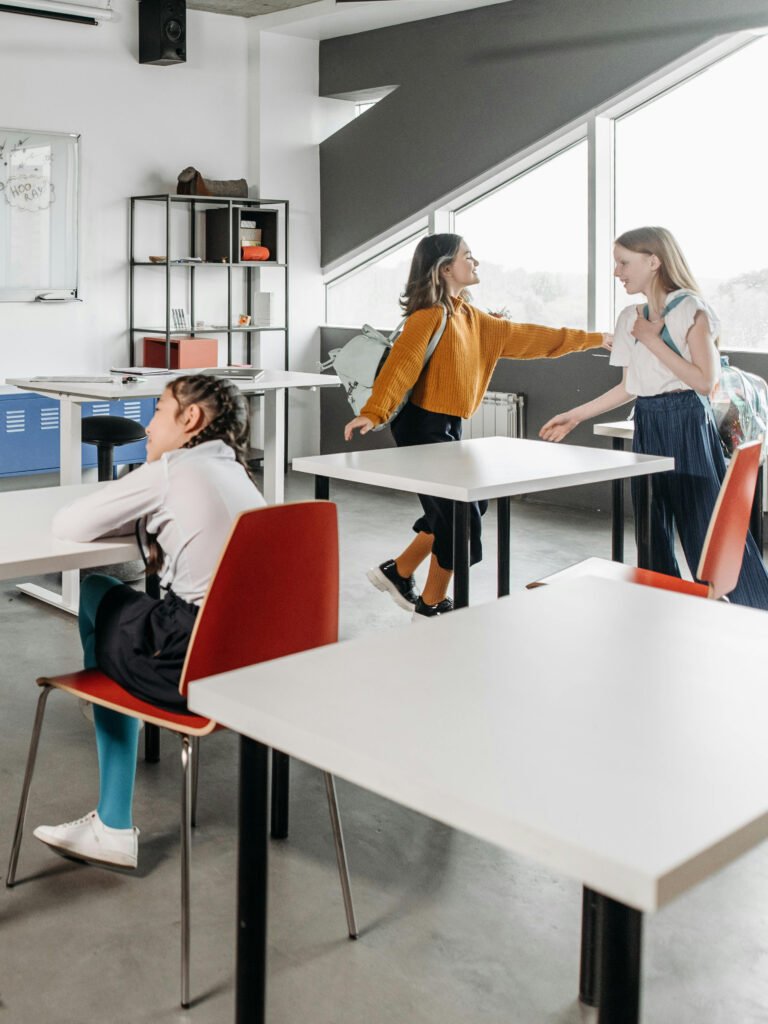Adjustable Student Desks vs. Non-Adjustable Student Desks: Which is Better for Teens?
Hey! Are you still wondering whether to buy a desk and chair with adjustable height?
It may not seem like a big difference, but this extra function will definitely affect your comfort

Desks and chairs are teaching equipment that students use for a long time from primary school to middle school and university. Whether their height and comfort are suitable has a great relationship with students’ physical health and learning efficiency. So how to choose is the first key control point. It is necessary for schools and parents to take a look!
Understand the height comparison table of desks and chairs

What are the dangers of students sitting on desks and chairs that do not match their height for a long time?
1、Affects body shape
Scoliosis: Inappropriate height of desks and chairs will make it impossible for students to maintain the natural curvature of the spine when sitting. For example, if the chair is too high, the feet will be suspended in the air, and the body weight will be concentrated on the hips and waist. In order to maintain balance, the spine will unconsciously bend sideways; if the desk is too high, students need to shrug their shoulders and stretch their necks to read and write, which will also cause uneven force on the spine. If this continues for a long time, it is easy to cause scoliosis.
Hunchback: If the desk is too low, students will bend down to get closer to the desk, which will keep the back muscles in a state of tension for a long time. Over time, the back muscles will fatigue, the normal physiological lordosis of the spine will disappear, and a hunchback will gradually form.
Causes muscle strain
Neck muscle strain: When the height of the desks and chairs is not appropriate, the position of the students’ heads will change. In order to see the books or blackboard clearly, the neck muscles need to continue to exert force to maintain the balance and posture of the head. For example, if the desk is too high, the head leans forward too much, and the neck muscles are stretched for a long time, it is easy to cause neck muscle strain, neck pain, stiffness and other symptoms.
Shoulder muscle strain: If the chair is too high or too low, the student’s shoulders will be at an unnatural height, and the arms will be affected when writing or operating. The shoulder muscles need to exert extra force to complete the movement. In the long run, the shoulder muscles will become tired and sore, and even cause diseases such as periarthritis of the shoulder.
Lumbar muscle strain: Inappropriate desks and chairs will prevent students from getting good support for their lumbar spine. If the chair is too soft or too low, the student’s waist will sink into the chair, the lumbar lordosis will increase, and the waist muscles need to continue to contract to maintain the body’s upright posture, which is easy to cause waist muscle strain and symptoms such as low back pain.
Affects vision
Myopia: Inappropriate height of desks and chairs may cause the distance between students’ eyes and books to be too close or too far. If the desk is too low, students need to bend down to see the book clearly, and the distance between the eyes and the book may be less than the normal distance of 33 cm. Long-term close-range use of the eyes will keep the ciliary muscles of the eyes in a state of tension and contraction, and the lens will become convex, thus causing myopia.
Strabismus: Due to problems with desks and chairs, students may adopt bad postures such as tilting their heads and squinting their eyes in order to see the blackboard or books clearly. Maintaining these postures for a long time will cause the line of sight of the two eyes to be inconsistent, and the strength of the extraocular muscles will be unbalanced, which will cause strabismus.

In addition, inappropriate desks and chairs may also affect students’ learning efficiency and concentration. Physical discomfort can easily distract students in class and make it difficult for them to concentrate on listening and learning. In the long run, this may have an adverse effect on their academic performance.
Compare the advantages and disadvantages of the two tables
1、Applicable population range
Adjustable desks: They are more applicable and can meet the needs of students of different grades and heights. Whether it is students from lower grades to higher grades in elementary school, or students with a large height change from junior high school to high school, they can adjust the height of the desk to adapt to their physical development.
Non-adjustable desks: They are usually suitable for students of a specific height range or a specific grade. If the student’s height exceeds or falls below the design standard, it may be uncomfortable to use, and may even have an adverse effect on physical development.
2、Flexibility of use
Adjustable desks: more flexible to use. Not only can they be adjusted according to the current height of the students, but they can also be changed at any time as the students grow taller. In addition, in different teaching scenarios, such as group discussions, laboratory classes, etc., adjustable desks can also adapt to different activity needs by adjusting the height.
Non-adjustable desks: less flexible, once installed and used, their height is fixed, and it is difficult to adapt to changes in student height and diverse teaching scene requirements. If you want to change the height of the desk to adapt to new teaching needs or student groups, you often need to replace the entire set of desks, which is costly.
3、Cost
Adjustable desks: Due to its adjustable function, it requires more technology and materials in design and manufacturing, so the cost is relatively high. Its price is usually more expensive than non-adjustable desks.
Non-adjustable desks: The structure is relatively simple, and the production process is relatively conventional, so the cost is low and the price is relatively cheap. This makes some schools with limited funds more inclined to choose non-adjustable desks.
4、Maintenance
Adjustable desks: Due to the presence of some adjustable parts and mechanical devices, maintenance is relatively complicated. It is necessary to regularly check whether the adjustment device is working properly, such as whether the hydraulic rod is leaking oil, whether the screws are loose, etc., to ensure the reliability and safety of its adjustment function.
Non-adjustable desks: The structure is simple, there is no complex adjustment device, and maintenance is relatively easy. Generally, it is only necessary to regularly check whether the structure of the table and chair is stable, whether the surface is damaged, and other routine problems.

Summarize
When choosing the right desk and chair, consider your preferences for price, maintenance, and comfort.
Visit our showroom or order a trial student desk and chair!




